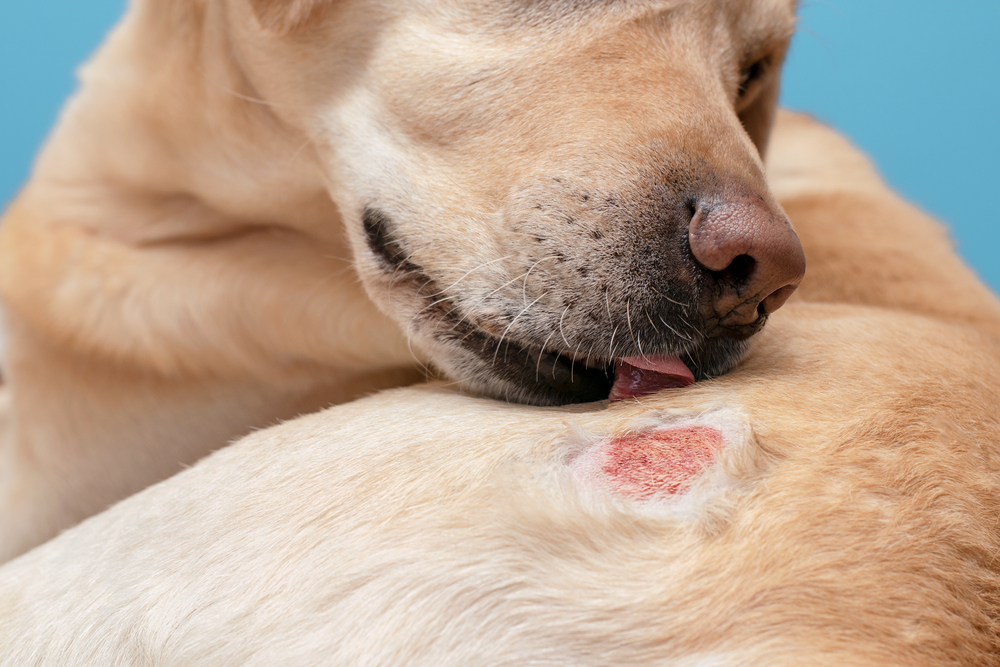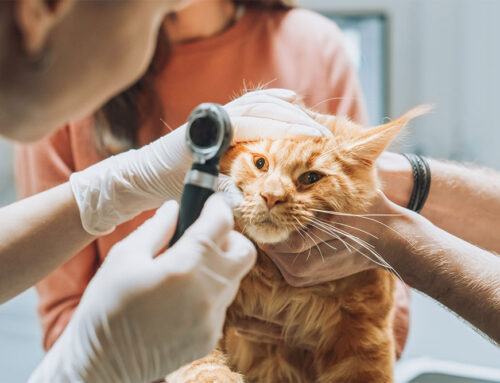Is your pet scratching or biting their skin? Dermatological or skin problems are among the most common reasons for veterinary visits. Cats and dogs can experience myriad skin conditions that can cause discomfort and distress. From itching and redness to hair loss and infection, a skin condition can impact your four-legged friend’s overall well-being. Our Livingston Veterinary Hospital team delves into some of the most common skin issues affecting pets, exploring their causes and discussing available treatments that can help relieve your furry pal’s itchiness and discomfort.
Pet skin condition #1: Flea allergy dermatitis
Flea allergy dermatitis (FAD) is one of pets’ most prevalent skin problems, particularly in dogs and cats. FAD occurs when a pet has an allergic reaction to flea saliva, leading to intense itching, and skin redness and inflammation. FAD signs may include:
- Excessive scratching
- Biting
- Hair loss, especially around the tail base and on their back
- Intense itchiness
- Skin redness
- Skin inflammation
FAD treatment involves flea control measures, such as topical or oral flea preventives, soothing baths, and medications, to alleviate itching and inflammation. Your home must also be treated, including washing all linens and sometimes using professional flea extermination.
Pet skin condition #2: Atopic dermatitis
Atopic dermatitis, also known as allergic dermatitis, is a chronic inflammatory skin condition caused by an allergic reaction to pollen, dust mites, mold, and other environmental triggers. Pets affected by atopic dermatitis may show the following signs:
- Itching
- Redness
- Recurrent ear infections
- Skin lesions
- Raised pimples or swellings
Atopic dermatitis management typically involves identifying and avoiding pets’ allergens when possible. Your pet can get symptomatic relief from medications such as antihistamines, corticosteroids, and immunotherapy.
Pet skin condition #3: Food allergy
Some pets are allergic to certain food ingredients, which can manifest as a skin problem, triggering an allergic reaction that leads to itching, rash, and gastrointestinal (GI) issues. Pets’ common food allergens include beef, chicken, dairy, wheat, and soy. Diagnosing a food allergy often requires an elimination diet trial conducted under our Livingston Veterinary Hospital team’s supervision. Treatment involves feeding a hypoallergenic or limited-ingredient diet tailored to your pet’s specific dietary needs and sensitivities.
Pet skin condition #4: Mange
Mange is a skin condition caused by mites infesting pets’ hair follicles and skin. Two primary mange types commonly affect pets: sarcoptic mange, which is caused by Sarcoptes scabies mites, and demodectic mange, which is caused by Demodex folliculorum mites. Pets’ mange signs may include:
- Intense itching, especially at night
- Hair loss
- Raised skin, including bumps or blisters
- Skin crusting
- Rash, which is also called scabies rash
- Skin infection
Mange can be treated effectively. Our team typically prescribes medicated shampoos, topical treatments, and oral medications to eliminate the mites and manage secondary infections.
Pet skin condition #5: Yeast infection
Yeast infections can affect your pet’s skin and ears. Yeast infection signs include:
- Itching
- Redness
- Greasy skin
- Foul odor
Yeast overgrowth often occurs in warm, moist body areas such as the ears, paws, and skinfolds. Treatment involves antifungal medications, medicated shampoos, and topical treatments to reduce yeast proliferation and alleviate physical effects. Bacteria and parasites can also cause pets’ skin infections.
Pet skin condition #6: Acute moist dermatitis

Acute moist dermatitis, or hot spots, are itchy, painful skin lesions. Hot spots are typically the result of underlying infections caused by other skin conditions. Pets’ hot spots signs include:
- Skin lesions
- Itching
- Redness
- Inflammation
- Pain
Treating hot acute moist dermatitis requires using medicated shampoos and topicals. Our team must also address underlying causes that contribute to hot spots, such as parasites, allergies, and infections.
Skin conditions can significantly impact your furry companion’s quality of life, causing discomfort and distress. By understanding skin problems’ common causes, signs, and treatments, you can address these issues and ensure your furry pal is healthy and happy. If your pet is experiencing a skin condition, call our Livingston Veterinary Hospital team so we can diagnose and treat your furry pal’s condition.







Leave A Comment